-
Attention please:
-
If you want to reprint my article, please mark the original address and author(刘书裴).
-
If you are puzzled about a certain part or have some better suggestions, you can contact me: 3017218062@tju.edu.cn/1005968086@qq.com
-
If my blog has mistakes, I'm so sorry!
-
I think and write everything. Please don't copy.
-
Thanks for watching!
| item | tool |
|---|---|
| image | mspaint |
| formula | Online LaTeX Equation Editor |
| language | python3.7 |
| date | 2020.8.1 |
| author | 刘书裴 |
- SRCNN(ECCV2014)
- FSRCNN(ECCV2016)
- ESPCN(CVPR2016)
- VDSR(CVPR2016)
- DRCN(CVPR2016)
- RED(NIPS2016)
- DRRN(CVPR2017)
- LapSRN(CVPR2017)
- SRDenseNet(ICCV2017)
- SRGAN/SRResNet(CVPR2017)
- MemNet(ICCV2017)
- EDSR(CVPRW2017)
- RDN(CVPR2018)
- RCAN(ECCV2018)
- DRN(CVPR2020)
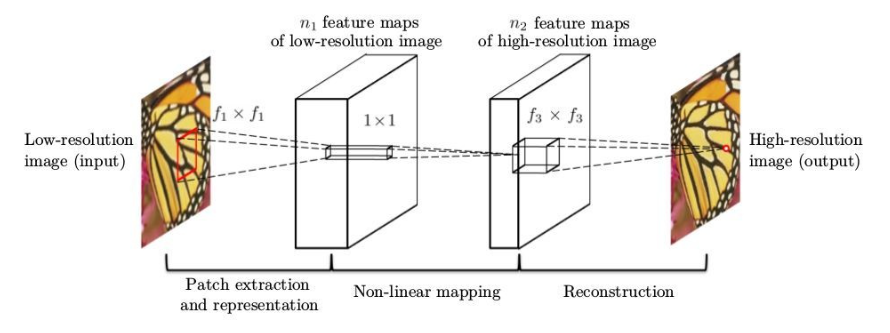
def SRCNN(inputShape=(128, 128, 3), scale=2):
i = Input(inputShape)
x = UpSampling2D(scale, interpolation="bilinear")(i)
x = Conv2D(64, 9, activation="relu", padding="same")(x)
x = Conv2D(32, 1, activation="relu")(x)
o = Conv2D(3, 5, padding="same")(x)
model = Model(i, o)
model.summary()
_________________________________________________________________
Layer (type) Output Shape Param #
=================================================================
input_1 (InputLayer) [(None, 128, 128, 3)] 0
_________________________________________________________________
up_sampling2d (UpSampling2D) (None, 256, 256, 3) 0
_________________________________________________________________
conv2d (Conv2D) (None, 256, 256, 64) 15616
_________________________________________________________________
conv2d_1 (Conv2D) (None, 256, 256, 32) 2080
_________________________________________________________________
conv2d_2 (Conv2D) (None, 256, 256, 3) 2403
=================================================================
Total params: 20,099
Trainable params: 20,099
Non-trainable params: 0
_________________________________________________________________
- "Upsampling→Reconstruction" is an effective method.
epoch: 20 batchs: 1 loss: mse
-------------------------------------------------------------------
| loss | PSNR | SSIM | val_loss | val_PSNR | val_SSIM |
-------------------------------------------------------------------
| 0.001894 | 28.5465 | 0.8557 | 0.002016 | 28.2668 | 0.8408 |
-------------------------------------------------------------------
All Time: 103.673252 s

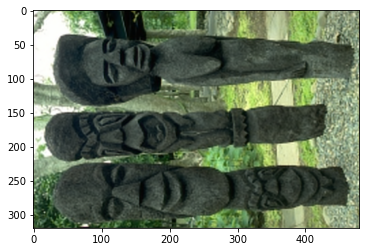
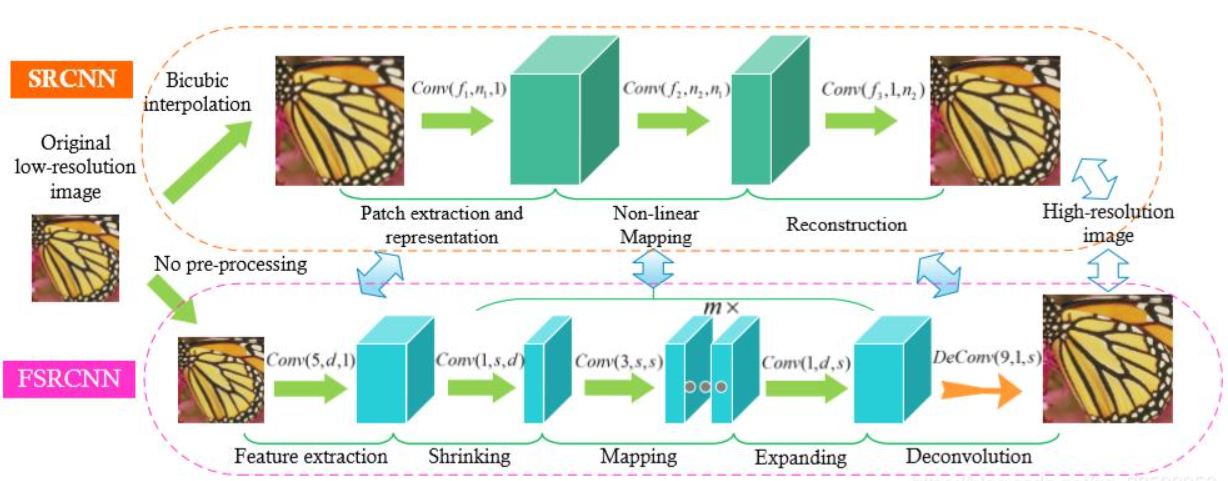
def FSRCNN(inputShape=(128, 128, 3), scale=2):
i = Input(inputShape)
x = Conv2D(56, 5, padding="same")(i)
x = PReLU()(x)
x = Conv2D(12, 1)(x)
x = PReLU()(x)
for _ in range(4):
x = Conv2D(12, 3, padding="same")(x)
x = PReLU()(x)
x = Conv2D(56, 1)(x)
x = PReLU()(x)
x = UpSampling2D(scale, interpolation="bilinear")(x)
o = Conv2D(3, 9, padding="same")(x)
model = Model(i, o)
model.summary()
_________________________________________________________________
Layer (type) Output Shape Param #
=================================================================
input_1 (InputLayer) [(None, 128, 128, 3)] 0
_________________________________________________________________
conv2d (Conv2D) (None, 128, 128, 56) 4256
_________________________________________________________________
p_re_lu (PReLU) (None, 128, 128, 56) 917504
_________________________________________________________________
conv2d_1 (Conv2D) (None, 128, 128, 12) 684
_________________________________________________________________
p_re_lu_1 (PReLU) (None, 128, 128, 12) 196608
_________________________________________________________________
conv2d_2 (Conv2D) (None, 128, 128, 12) 1308
_________________________________________________________________
p_re_lu_2 (PReLU) (None, 128, 128, 12) 196608
_________________________________________________________________
conv2d_3 (Conv2D) (None, 128, 128, 12) 1308
_________________________________________________________________
p_re_lu_3 (PReLU) (None, 128, 128, 12) 196608
_________________________________________________________________
conv2d_4 (Conv2D) (None, 128, 128, 12) 1308
_________________________________________________________________
p_re_lu_4 (PReLU) (None, 128, 128, 12) 196608
_________________________________________________________________
conv2d_5 (Conv2D) (None, 128, 128, 12) 1308
_________________________________________________________________
p_re_lu_5 (PReLU) (None, 128, 128, 12) 196608
_________________________________________________________________
conv2d_6 (Conv2D) (None, 128, 128, 56) 728
_________________________________________________________________
p_re_lu_6 (PReLU) (None, 128, 128, 56) 917504
_________________________________________________________________
up_sampling2d (UpSampling2D) (None, 256, 256, 56) 0
_________________________________________________________________
conv2d_7 (Conv2D) (None, 256, 256, 3) 13611
=================================================================
Total params: 2,842,559
Trainable params: 2,842,559
Non-trainable params: 0
_________________________________________________________________
- The accuracy and speed can be improved by changing "Upsampling→Reconstruction" to "Reconstruction→Upsampling".
- "Upsampling→Reconstruction" uses more RAM and GPU.
epoch: 20 batchs: 1 loss: mse
-------------------------------------------------------------------
| loss | PSNR | SSIM | val_loss | val_PSNR | val_SSIM |
-------------------------------------------------------------------
|| 0.002451 | 27.1810 | 0.8189 | 0.002527 | 27.0467 | 0.8047 |
-------------------------------------------------------------------
All Time: 189.835127 s

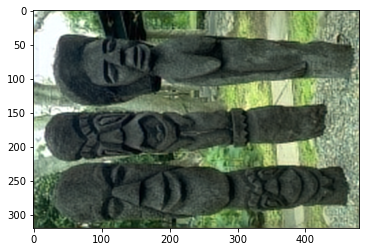

def ESPCN(inputShape=(128, 128, 3), scale=2):
i = Input(inputShape)
x = Conv2D(64, 5, activation="tanh", padding="same")(i)
x = Conv2D(32, 3, activation="tanh", padding="same")(x)
x = Conv2D(3 * (scale ** 2), 3, padding="same")(x)
o = Lambda(tf.nn.depth_to_space, arguments={"block_size": scale}, name="PixelShuffle")(x)
model = Model(i, o)
model.summary()
_________________________________________________________________
Layer (type) Output Shape Param #
=================================================================
input_1 (InputLayer) [(None, 128, 128, 3)] 0
_________________________________________________________________
conv2d (Conv2D) (None, 128, 128, 64) 4864
_________________________________________________________________
conv2d_1 (Conv2D) (None, 128, 128, 32) 18464
_________________________________________________________________
conv2d_2 (Conv2D) (None, 128, 128, 12) 3468
_________________________________________________________________
PixelShuffle (Lambda) (None, 256, 256, 3) 0
=================================================================
Total params: 26,796
Trainable params: 26,796
Non-trainable params: 0
_________________________________________________________________
- A sub-pixel convolution layer is proposed to replace the upsampling layer.
- Pixelsuffle is faster than upsampling, the effect is close, and the deconvolution precision and speed are bad.
epoch: 20 batchs: 1 loss: mse
-------------------------------------------------------------------
| loss | PSNR | SSIM | val_loss | val_PSNR | val_SSIM |
-------------------------------------------------------------------
| 0.002100 | 27.8614 | 0.8559 | 0.002086 | 27.9561 | 0.8454 |
-------------------------------------------------------------------
All Time: 82.055864 s


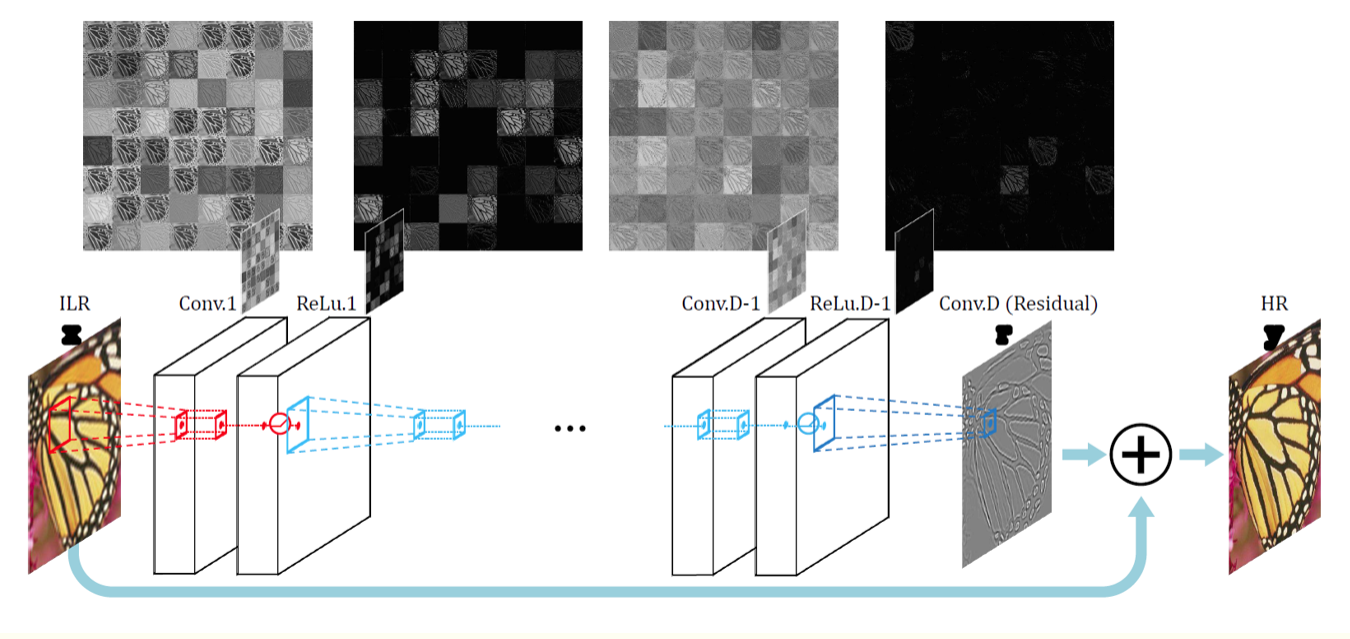
def VDSR(inputShape=(128, 128, 3), scale=2, d=20):
i = Input(inputShape)
x = UpSampling2D(scale, interpolation="bilinear")(i)
_x = Conv2D(64, 3, activation="relu", padding="same")(x)
for _ in range(d - 2):
_x = Conv2D(64, 3, activation="relu", padding="same")(_x)
_x = Conv2D(3, 3, padding="same")(_x)
o = Add()([x, _x])
model = Model(i, o)
model.summary()
__________________________________________________________________________________________________
Layer (type) Output Shape Param # Connected to
==================================================================================================
input_1 (InputLayer) [(None, 128, 128, 3) 0
__________________________________________________________________________________________________
up_sampling2d (UpSampling2D) (None, 256, 256, 3) 0 input_1[0][0]
__________________________________________________________________________________________________
conv2d (Conv2D) (None, 256, 256, 64) 1792 up_sampling2d[0][0]
__________________________________________________________________________________________________
conv2d_1 (Conv2D) (None, 256, 256, 64) 36928 conv2d[0][0]
__________________________________________________________________________________________________
conv2d_2 (Conv2D) (None, 256, 256, 64) 36928 conv2d_1[0][0]
__________________________________________________________________________________________________
conv2d_3 (Conv2D) (None, 256, 256, 64) 36928 conv2d_2[0][0]
__________________________________________________________________________________________________
conv2d_4 (Conv2D) (None, 256, 256, 64) 36928 conv2d_3[0][0]
__________________________________________________________________________________________________
conv2d_5 (Conv2D) (None, 256, 256, 64) 36928 conv2d_4[0][0]
__________________________________________________________________________________________________
conv2d_6 (Conv2D) (None, 256, 256, 64) 36928 conv2d_5[0][0]
__________________________________________________________________________________________________
conv2d_7 (Conv2D) (None, 256, 256, 64) 36928 conv2d_6[0][0]
__________________________________________________________________________________________________
conv2d_8 (Conv2D) (None, 256, 256, 64) 36928 conv2d_7[0][0]
__________________________________________________________________________________________________
conv2d_9 (Conv2D) (None, 256, 256, 64) 36928 conv2d_8[0][0]
__________________________________________________________________________________________________
conv2d_10 (Conv2D) (None, 256, 256, 64) 36928 conv2d_9[0][0]
__________________________________________________________________________________________________
conv2d_11 (Conv2D) (None, 256, 256, 64) 36928 conv2d_10[0][0]
__________________________________________________________________________________________________
conv2d_12 (Conv2D) (None, 256, 256, 64) 36928 conv2d_11[0][0]
__________________________________________________________________________________________________
conv2d_13 (Conv2D) (None, 256, 256, 64) 36928 conv2d_12[0][0]
__________________________________________________________________________________________________
conv2d_14 (Conv2D) (None, 256, 256, 64) 36928 conv2d_13[0][0]
__________________________________________________________________________________________________
conv2d_15 (Conv2D) (None, 256, 256, 64) 36928 conv2d_14[0][0]
__________________________________________________________________________________________________
conv2d_16 (Conv2D) (None, 256, 256, 64) 36928 conv2d_15[0][0]
__________________________________________________________________________________________________
conv2d_17 (Conv2D) (None, 256, 256, 64) 36928 conv2d_16[0][0]
__________________________________________________________________________________________________
conv2d_18 (Conv2D) (None, 256, 256, 64) 36928 conv2d_17[0][0]
__________________________________________________________________________________________________
conv2d_19 (Conv2D) (None, 256, 256, 3) 1731 conv2d_18[0][0]
__________________________________________________________________________________________________
add (Add) (None, 256, 256, 3) 0 up_sampling2d[0][0]
conv2d_19[0][0]
==================================================================================================
Total params: 668,227
Trainable params: 668,227
Non-trainable params: 0
__________________________________________________________________________________________________
- Residual network is a very effective feature extraction method.
- The deeper the network is, the better the effect is.
epoch: 20 batchs: 1 loss: mse layers: 10
-------------------------------------------------------------------
| loss | PSNR | SSIM | val_loss | val_PSNR | val_SSIM |
-------------------------------------------------------------------
| 0.001528 | 29.7323 | 0.8780 | 0.001686 | 29.2822 | 0.8626 |
-------------------------------------------------------------------
All Time: 301.103052 s

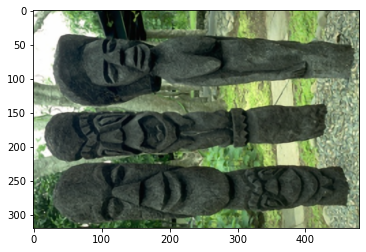


- Recursive supervision is an effective method and greatly reduces the number of parameters.

def RED(inputShape=(128, 128, 3), scale=2, d=6):
i = Input(inputShape)
x = UpSampling2D(scale, interpolation="bilinear")(i)
_x = Conv2D(64, 3, padding="same")(x)
res = []
for _ in range(d):
res.append(_x)
_x = Conv2D(64, 3, activation="relu", padding="same")(_x)
_x = Conv2D(64, 3, strides=2, activation="relu", padding="same")(_x)
for _ in range(d):
_x = Conv2DTranspose(64, 3, activation="relu", padding="same")(_x)
_x = Conv2DTranspose(64, 3, strides=2, activation="relu", padding="same")(_x)
_x = Add()([_x, res[-_ - 1]])
_x = Conv2D(3, 3, padding="same")(_x)
o = Add()([x, _x])
model = Model(i, o)
model.summary()
epoch: 20 batchs: 1 loss: mse layers: 3
-------------------------------------------------------------------
| loss | PSNR | SSIM | val_loss | val_PSNR | val_SSIM |
-------------------------------------------------------------------
| 0.001566 | 29.5791 | 0.8762 | 0.001716 | 29.1709 | 0.8618 |
-------------------------------------------------------------------
All Time: 505.542007 s


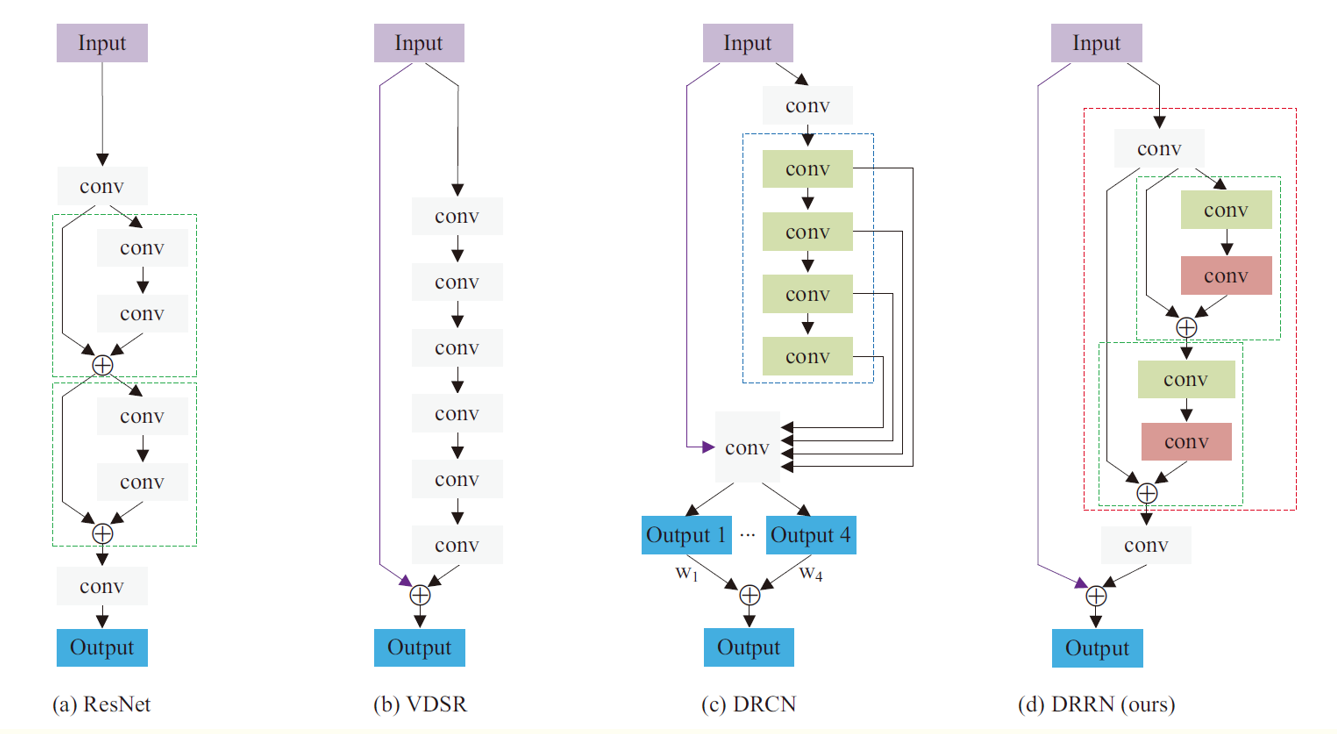
def DRRN(inputShape=(128, 128, 3), scale=2, b=1, u=25):
def RB(x, u=9):
convLayer = Sequential([
Conv2D(128, 3, activation="relu", padding="same"),
Conv2D(128, 3, activation="relu", padding="same"),
])
x = Conv2D(128, 3, activation="relu", padding="same")(x)
_x = tf.identity(x)
for _ in range(u):
x = convLayer(x)
x = Add()([x, _x])
return x
i = Input(inputShape)
x = UpSampling2D(scale, interpolation="bilinear")(i)
_x = tf.identity(x)
for _ in range(b):
x = RB(x, u=u)
x = Conv2D(3, 3, padding="same")(x)
o = Add()([x, _x])
model = Model(i, o)
model.summary()
- Local residual learning is also very effective.
- The combination of local residual learning and global residual learning can achieve great results.
epoch: 20 batchs: 1 loss: mse b: 1 u: 10
-------------------------------------------------------------------
| loss | PSNR | SSIM | val_loss | val_PSNR | val_SSIM |
-------------------------------------------------------------------
| 0.001556 | 29.6228 | 0.8769 | 0.001703 | 29.2317 | 0.8630 |
-------------------------------------------------------------------
All Time: 885.808055 s


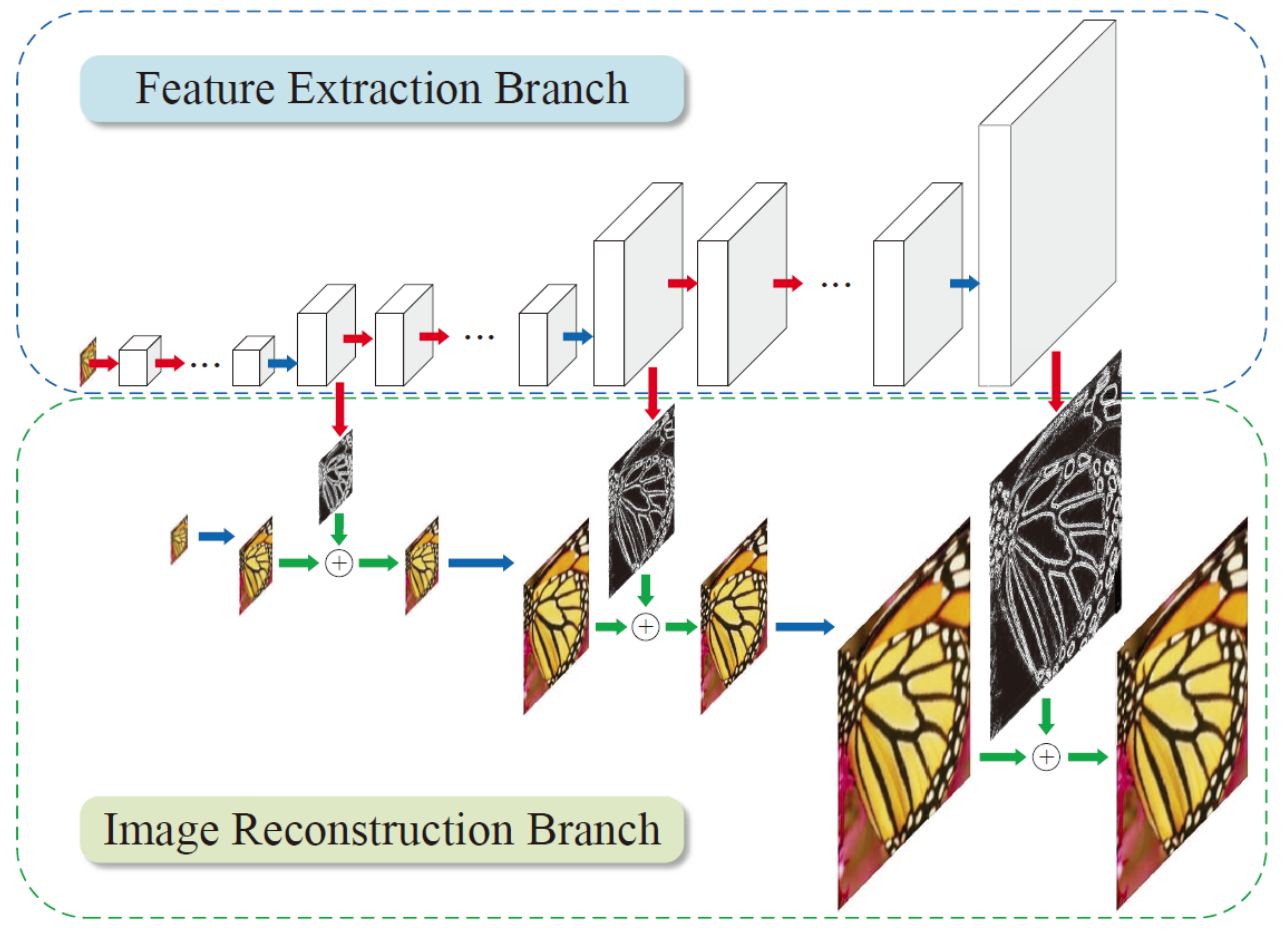
- The effect of multi-stage upsampling is better than that of single-stage upsampling.
- Add loss to each upsampling for monitoring.
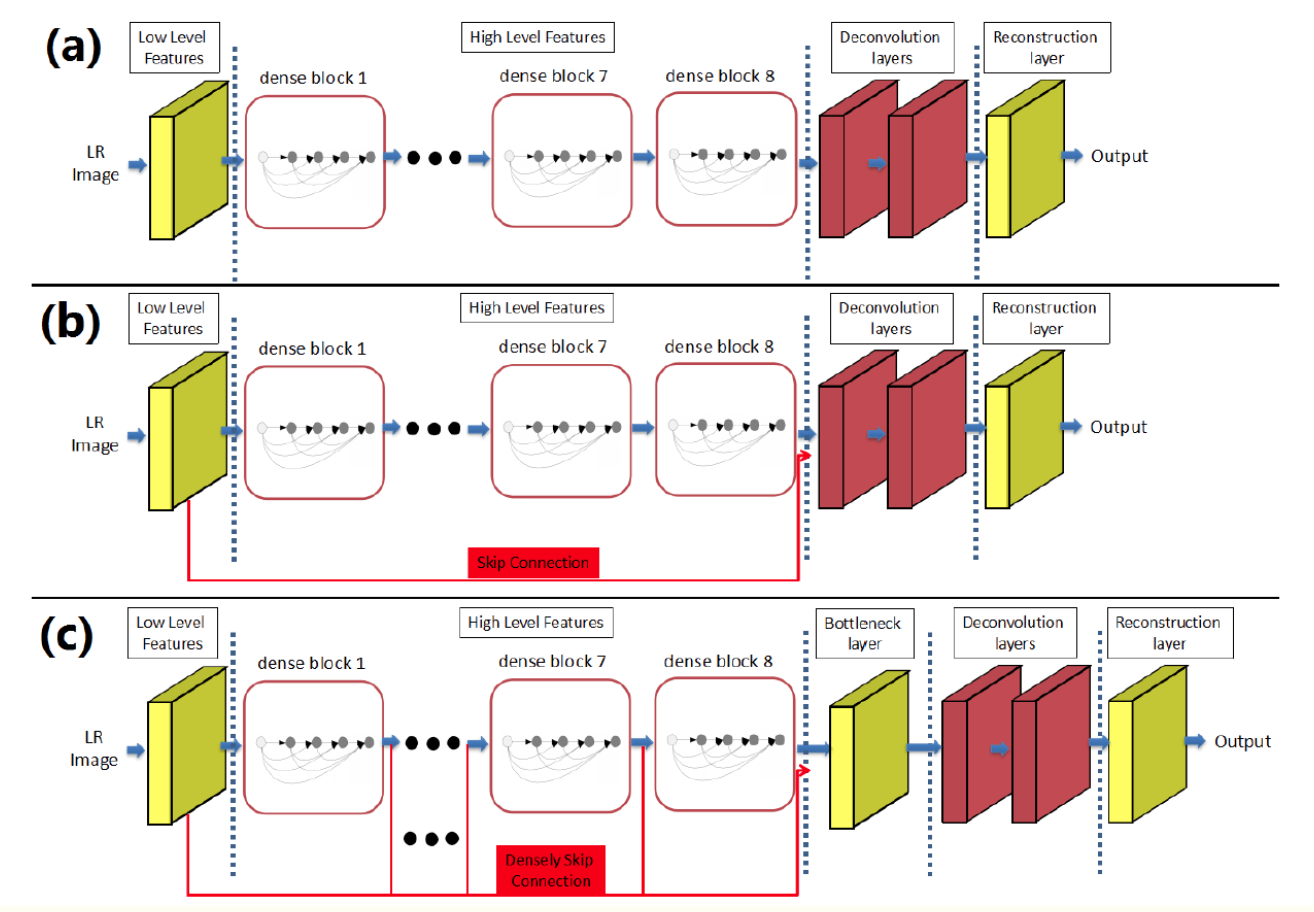
- The information contained in different depth layers is complementary.
- For too big feature map, add a 1×1 convolution bottleneck layer to reduce the number of features.
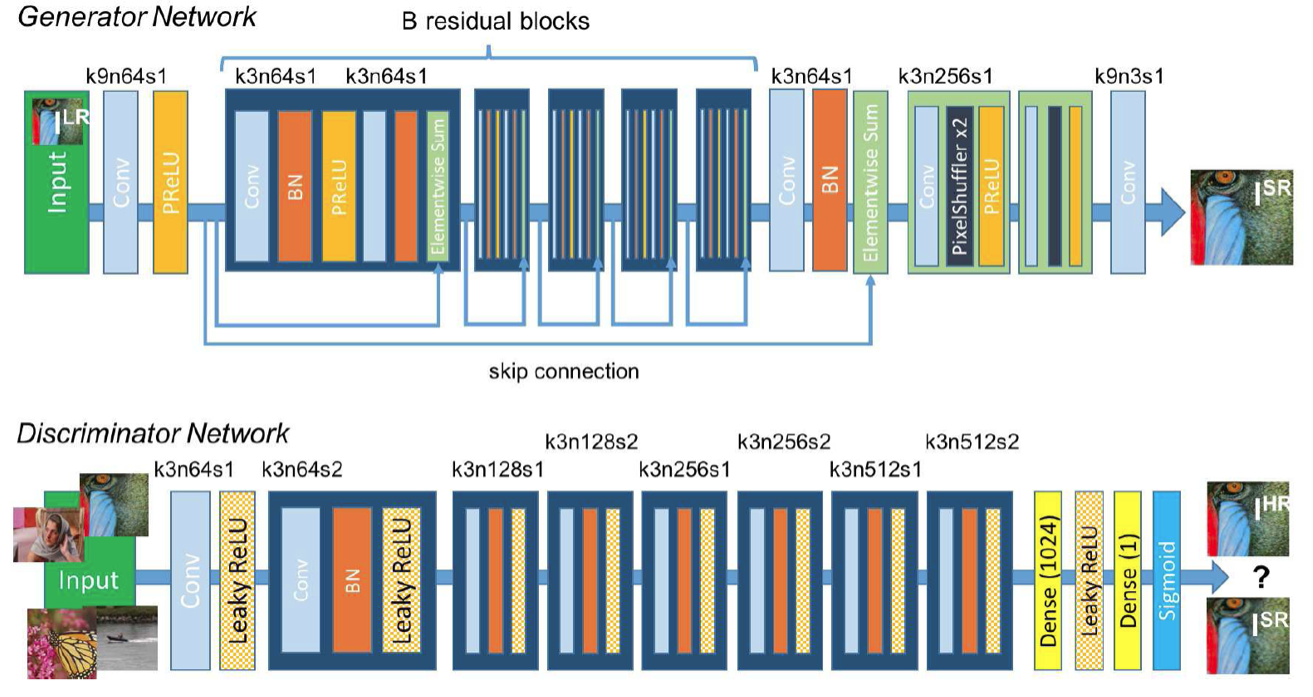

- Like DRCN, long term memory has a strong learning ability.
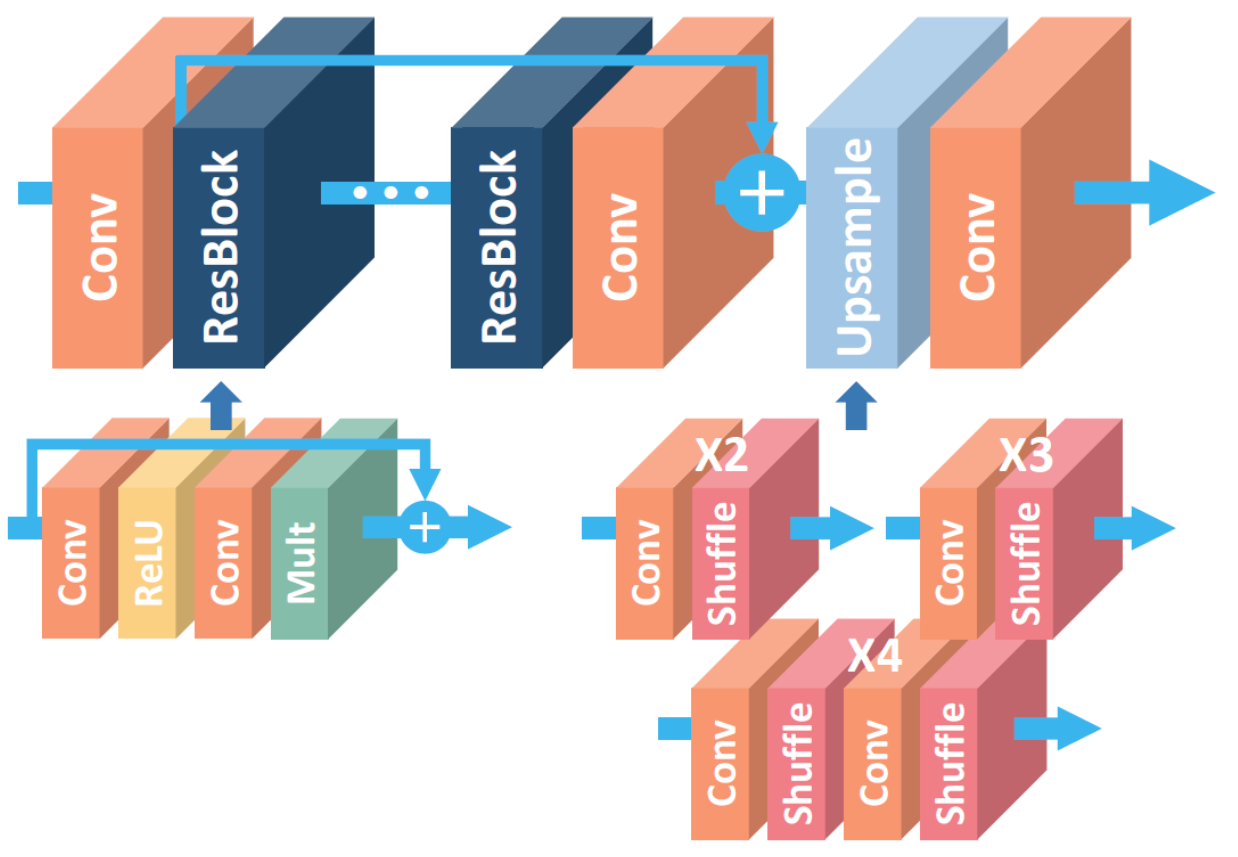
- The redundant modules of SRResNet are removed, so the size of the model can be enlarged to improve the quality of the results.

def RDN(inputShape=(128, 128, 3), scale=2, d=16, c=8):
def DenseBlock(x, num):
filters = x.shape[-1]
res = tf.identity(x)
for _ in range(num):
x = Conv2D(filters, 3, activation="relu", padding="same")(x)
x = concatenate([res, x], axis=-1)
res = tf.identity(x)
return x
def RDB(x, num):
_x = tf.identity(x)
_x = DenseBlock(_x, num)
_x = Conv2D(x.shape[-1], 1)(_x)
return Add()([x, _x])
i = Input(inputShape)
x = Conv2D(64, 3, padding="same")(i)
_x = Conv2D(64, 3, padding="same")(x)
if d > 1:
Fs = []
for _ in range(d):
_x = RDB(_x, c)
Fs.append(_x)
_x = concatenate(Fs, axis=-1)
else:
_x = RDB(_x, c)
_x = Conv2D(_x.shape[-1], 1)(_x)
_x = Conv2D(64, 3, padding="same")(_x)
x = Add()([x, _x])
x = UpSampling2D(scale, interpolation="bilinear")(x)
o = Conv2D(3, 3, padding="same")(x)
model = Model(i, o)
model.summary()
- Residual block and dense block are integrated to obtain global and local details.
- A common procedure:

epoch: 20 batchs: 1 loss: mae d: 3 c: 3
-------------------------------------------------------------------
| loss | PSNR | SSIM | val_loss | val_PSNR | val_SSIM |
-------------------------------------------------------------------
| 0.022781 | 29.4102 | 0.8751 | 0.024152 | 29.0181 | 0.8606 |
-------------------------------------------------------------------
All Time: 288.672599 s


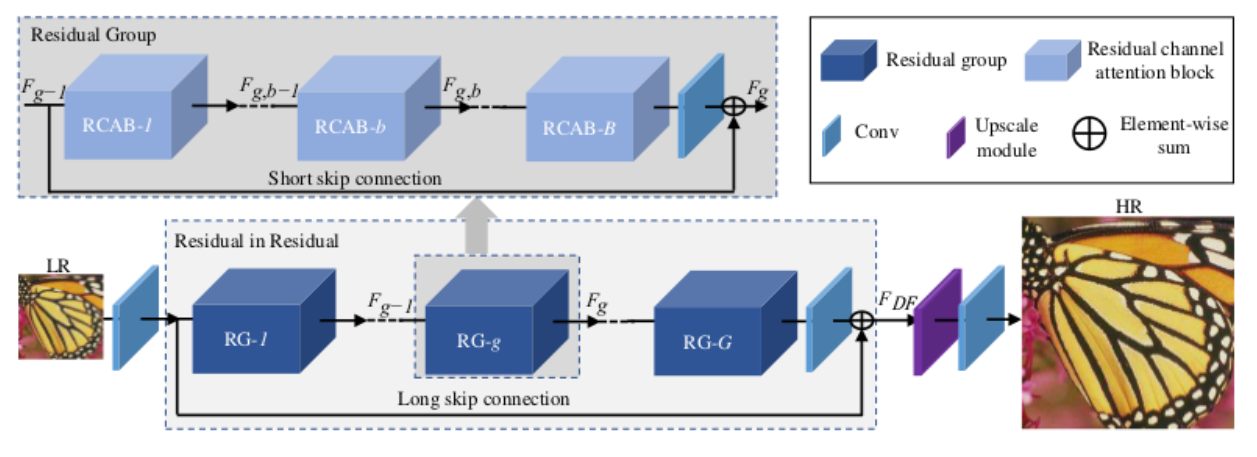
def RCNN(inputShape=(128, 128, 3), scale=2, g=10, b=20):
def SEBlock(x, reduction=16):
_x = GlobalAveragePooling2D()(x)
_x = Conv2D(x.shape[-1] // reduction, 1, padding="same", use_bias=True, activation="relu")(_x[:, None, None, :])
_x = Conv2D(x.shape[-1], 1, padding="same", use_bias=True, activation="sigmoid")(_x)
return Multiply()([x, _x])
def RCAB(x, reduction=16):
_x = Conv2D(x.shape[-1], 3, activation="relu", padding="same")(x)
_x = Conv2D(x.shape[-1], 3, padding="same")(_x)
_x = SEBlock(_x, reduction=reduction)
return Add()([x, _x])
def RG(x, b=20, reduction=16):
_x = RCAB(x, reduction=reduction)
for _ in range(b - 1):
_x = RCAB(_x, reduction=reduction)
_x = Conv2D(x.shape[-1], 3, padding="same")(_x)
return Add()([x, _x])
def RIR(x, g=10, b=20, reduction=16):
_x = RG(x, b=b, reduction=reduction)
for _ in range(g - 1):
_x = RG(_x, b=b, reduction=reduction)
_x = Conv2D(x.shape[-1], 3, padding="same")(_x)
return Add()([x, _x])
i = Input(inputShape)
x = Conv2D(64, 3, padding="same")(i)
x = RIR(x, g=g, b=b, reduction=16)
x = Conv2D(3 * (scale ** 2), 3, padding="same")(x)
o = Lambda(tf.nn.depth_to_space, arguments={"block_size": scale}, name="PixelShuffle")(x)
model = Model(i, o)
model.summary()
- The RIR structure allows rich low-frequency information to be transmitted directly through multiple hop connections, making the main network focus on learning high-frequency information.
- CA can adaptively adjust the features by considering the interdependence between channels, allowing the network to focus on more useful channels and enhance the ability of discrimination learning.
epoch: 20 batchs: 1 loss: mse g: 3 b: 3
-------------------------------------------------------------------
| loss | PSNR | SSIM | val_loss | val_PSNR | val_SSIM |
-------------------------------------------------------------------
| 0.023261 | 29.2964 | 0.8715 | 0.024254 | 29.0065 | 0.8595 |
-------------------------------------------------------------------
All Time: 319.869376 s


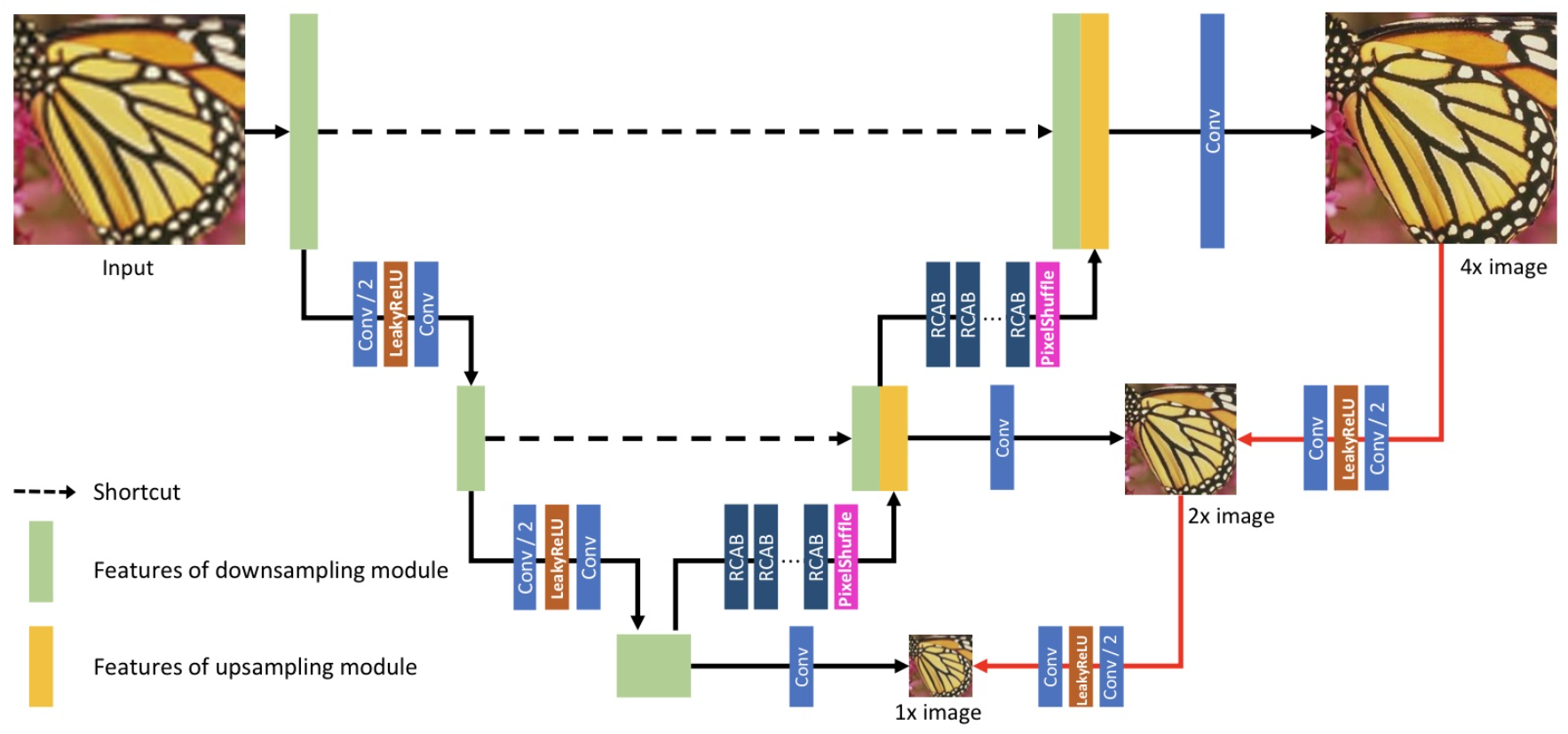
- Dual regression strategy reduces the size of solution space by introducing additional constraints on LR images.
- It is effective to calculate the loss of multi-scale image without adding too many parameters.